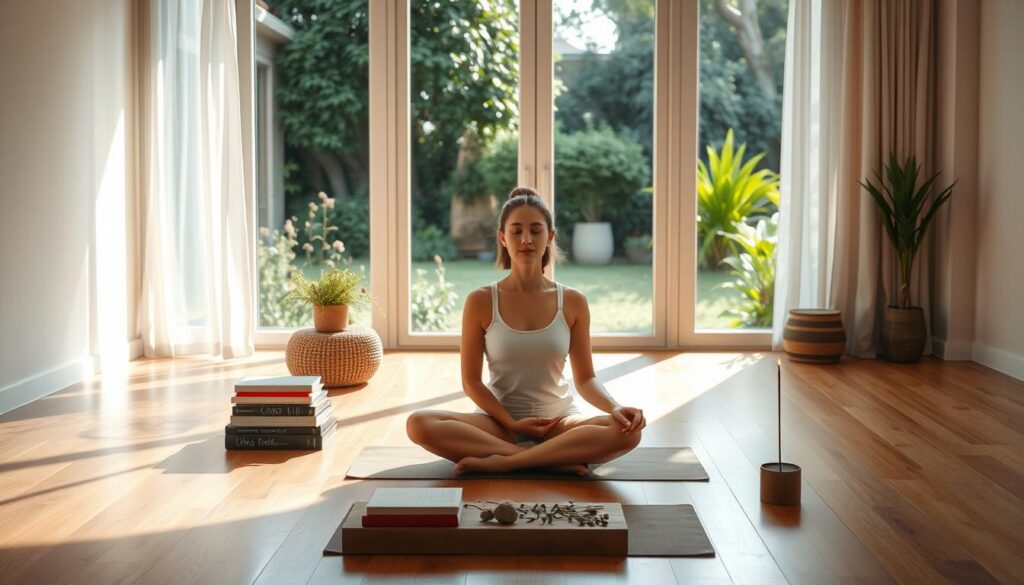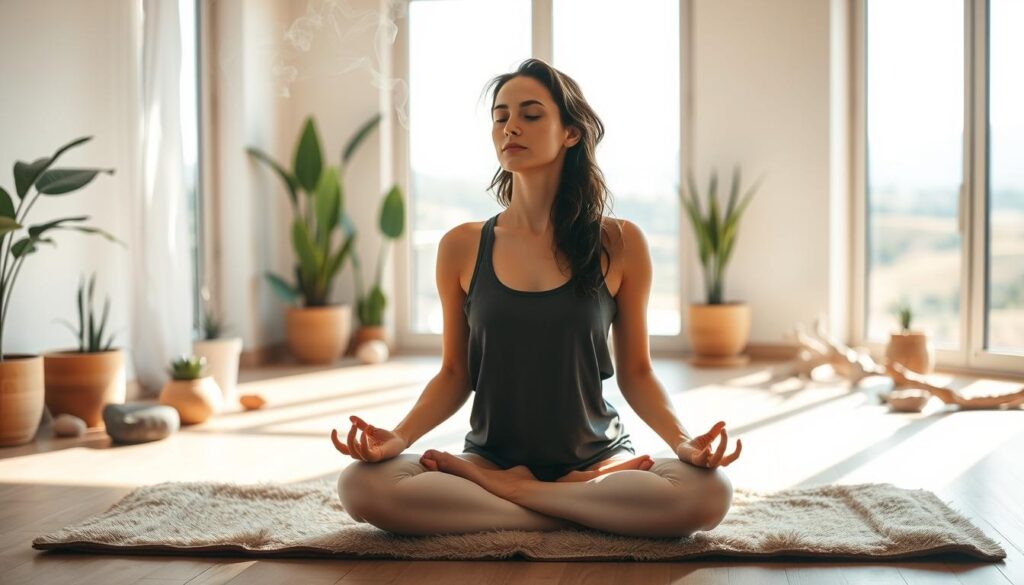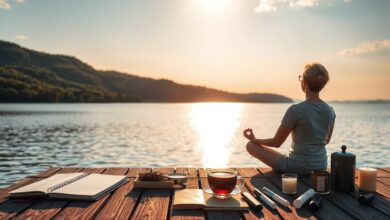Uplift Your Wellbeing with Wellness Activities

Imagine you’re scrolling through a busy day, feeling overwhelmed. What if you could pause and breathe? Wellness activities are for everyone, not just the perfectly balanced or disciplined. They help turn daily moments into chances to feel stronger and more alive.
Whether it’s a short walk, journaling, or sipping water mindfully, small steps matter. They add up to a healthier, happier you.
HealthyHealthy living isn’t about big changes—it’s about making choices that fit your life. Simple acts like stretching or laughing with friends can change your day. This article shows how small wellness activities can improve your health and happiness.
Let’s find out how to create a routine that suits you, no matter where you begin.
Key Takeaways
- Wellness activities improve mental and physical health through simple, daily actions.
- Healthy living is accessible—no special equipment or time constraints required.
- Self-care practices like mindfulness or nature walks reduce stress instantly.
- Everyday routines can be transformed into opportunities for holistic wellbeing.
- Discover actionable tips to start building your personalized wellness plan today.
Understanding the Power of Wellness Activities in Everyday Life
Wellness activities are more than just trends. They are steps towards a healthier life. By adding self-care to our daily routines, we lay a strong foundation for well-being. Simple actions like deep breathing or a walk in nature can greatly improve our health.
What Defines a Wellness Activity?
Wellness activities focus on purpose, not perfection. They:
- Are done with awareness of their impact
- Find a balance between effort and ease
- Match our personal values for consistency
The Five Dimensions of Wellbeing
True wellness covers all these areas:
- Physical: Exercise, nutrition, sleep
- Emotional: Stress management through journaling or therapy
- Social: Building relationships through community
- Intellectual: Learning new skills or hobbies
- Spiritual: Meditation, volunteering, or nature
How Regular Wellness Practices Transform Health
“Wellness isn’t about being perfect—it’s about progress.”
A 2023 Mayo Clinic study found that self-care can lower stress hormones by up to 23%. Simple habits like stretching or journaling can boost our immune system and brain function. These small steps help us build resilience and live healthier lives.
Physical Wellness Activities to Energize Your Body
Getting active doesn’t need a gym or hard workouts. Simple, fun wellness activities can increase energy. Start small and make habits that fit your life.
Low-Impact Exercises for Beginners
Start with easy moves like walking, swimming, or yoga. These lower injury risk and boost heart health. Try a 20-minute walk each day or join a pool for water aerobics. Stretching also helps with stiffness and balance.
Strength Training for Longevity
Keeping muscles strong is vital for aging well. Use bodyweight exercises like push-ups, squats, or resistance bands at home. Add core workouts like planks. Healthy living means building strength to prevent falls and support metabolism.
Outdoor Activities That Boost Overall Health
“Sunlight and fresh air during hikes or bike rides can elevate mood while burning calories.”
Explore trails, garden, or join outdoor group classes. Being in nature lowers stress hormones, making these fitness routines great for both mind and body.
Creating a Sustainable Fitness Routine
- Set realistic goals, like 30 minutes 3x a week.
- Alternate activities to avoid burnout (e.g., yoga one day, cycling the next).
- Track progress with apps like Fitbit or MyFitnessPal for motivation.
Consistency is key, not perfection. Celebrate small victories to keep your wellness activities fun and lasting.
Mental Wellness Practices for a Clearer Mind
Mental clarity comes from small, consistent wellness activities. These activities sharpen focus and cut down stress. Daily reading or learning a new language boosts brain function and supports neuroplasticity. Just 10 minutes of focused practice can be beneficial.
- Puzzles and Brain Games: Crosswords, Sudoku, or memory apps challenge cognitive pathways.
- Learning New Skills: Cooking classes or instrument lessons create neural connections.
- Journaling: Writing thoughts clarifies emotions and supports mental organization.
| Mindfulness Exercise | Time Needed | Benefits |
|---|---|---|
| Meditation | 5-15 mins | Reduces anxiety, improves focus |
| Yoga | 20-30 mins | Combines movement with mental calm |
| Deep Breathing | 2-3 mins | Quick stress relief |
Digital detox is also important. Cutting down on screen time before bed and setting tech-free hours helps protect mental space. Add self-care practices like short walks or mindful breathing during breaks. Small changes can make a big difference—try these steps:
- Replace 1 hour of scrolling with a puzzle or book
- Practice 3 deep breaths before starting tasks
- Set a daily 10-minute meditation goal
“The brain thrives on novelty and calm—both are essential for sustained cognitive health.” – Dr. Lisa Hayes, Neuroscientist
These practices work best when combined with physical wellness routines. Even busy schedules can fit in these steps. They create a strong foundation for long-term mental resilience.
Emotional Well-being Activities to Process Feelings Healthily
Emotional well-being activities are key to self-care. They help you deal with life’s ups and downs. These activities make sure your feelings are heard without being judged. They build your strength.
Journaling Techniques for Emotional Release
Writing is a strong way to clear your emotions. Try these methods:
- Gratitude journaling: Write down three good things each day to focus on happiness.
- Emotional tracking: Record what makes you upset and how you react to find patterns.
- Stream-of-consciousness writing: Write whatever comes to mind without stopping or editing.
Building Community Connections for Support
A strong support network is vital for emotional healthhealth. Think about:
- Joining local or online groups that share your interests.
- Setting up regular meetings with friends over coffee or walks.
- Volunteering to meet new people and help others.
“Community is where we grow most authentically.”
Creative Expression as Emotional Therapy
Artistic activities like painting, music, or dance let emotions flow freely. You don’t need to be good at it. Just let your creativity flow. Watercolor painting or writing a poem can be your way to release emotions. Even dancing by yourself is a wellness activity. Creating something is healing.
By embracing these practices, emotional processing becomes a natural part of self-care. Every small step helps build a strong foundation for emotional health.
Stress Relief Techniques for Modern Life Challenges
In today’s fast-paced world, finding effective stress relief techniques is key to maintaining wellness activities that support healthy living. Simple practices can turn everyday moments into opportunities to recharge.
Breathing Exercises for Immediate Calm
When stress spikes, breathing techniques reset your focus. Try these steps:
- Box Breathing: Inhale for 4 counts, hold for 4, exhale for 4, pause for 4. Repeat for 2-3 minutes.
- 4-7-8 Technique: Breathe in quietly for 4, hold for 7, exhale slowly for 8. Ideal before stressful tasks.
“Breathing practices reduce cortisol by up to 25% in just 10 minutes,” notes a 2023 study in *Health Psychology*.
Nature-Based Stress Reduction Methods
Spending time outdoors triggers a natural stress response. Urban dwellers can garden in small spaces, walk in local parks, or even care for houseplants. Research shows just 20 minutes in green spaces lowers heart rate by 5%.
Technology Breaks as Stress Management
Limit screen time with these tips:
- Set 30-minute “tech-free” blocks daily.
- Use apps like Forest to track focus time offline.
- Replace scrolling with a walk or a book.
These small shifts help reclaim mental space, fostering resilience against digital overwhelm.
Mindfulness Exercises to Cultivate Present-Moment Awareness
Mindfulness exercises are simple ways to stay in the moment. They don’t need special equipment or a quiet place. You can do them while drinking coffee or waiting in line. They help you focus on your senses and calm your mind.

- Body Scan: Lie comfortably and mentally scan from toes to head, noticing sensations without judgment.
- Mindful Walking: Walk slowly, feeling each step’s pressure, the air on your skin, and the rhythm of breath.
- 5-4-3-2-1 Grounding: Name 5 things you see, 4 you feel, 3 you hear, 2 you smell, and 1 you taste to snap into the present.
Many think mindfulness means clearing your mind. But it’s about gently focusing when your mind wanders. Even 60 seconds of mindful eating can help. Try noticing your surroundings at red lights or enjoy the feel of warm water while washing dishes.
Studies show mindfulness can lower stress and improve focus. Begin with short moments each day. Turn daily tasks like commuting or eating into mindfulness exercises. Remember, it’s the regular practice that counts, not being perfect.
Nutrition as a Cornerstone of Wellness Activities
Eating well is key to healthy living and daily self-care practices. Good food boosts energy, sharpens the mind, and boosts overall health. It’s vital for a balanced life.
Meal Planning for Nutritional Balance
Begin with meals centered on whole foods like veggies, lean proteins, and grains. Here are some tips:
- Plan meals with a variety of colorful veggies for different nutrients
- Stock up on oats, legumes, and frozen veggies for quick meals
- Get family involved in choosing meals that are both tasty and healthy
Mindful Eating Practices
“Eating with intention turns meals into moments of self-care,” says registered dietitian Sarah Thompson. “Take 20 minutes to savor each bite and listen to your body’s fullness signals.”
Turn off screens during meals to enjoy flavors and listen to your hunger. This helps avoid overeating and builds a better food relationship.
Hydration Habits for Optimal Functioning
Water is essential for our bodies. Try these hydration tips:
- Carry a refillable bottle with infused water (like cucumber and lemon)
- Use apps like WaterMinder to track your water intake
- Enjoy herbal teas and 100% fruit juices in moderation for extra flavor
Make nutrition a fun part of your wellness journey. Small, regular choices lead to lasting healthy habits.
Social Wellness Activities That Strengthen Relationships
Healthy living isn’t just about your body or mind. It’s also about building strong social bonds. Studies show that good relationships can lower stress and improve your mood. A Harvard study found that people with close friends live longer, showing how important social wellness is.
“Social isolation poses risks comparable to smoking or obesity.” – Brigham Young University research
Begin with simple steps: schedule weekly coffee dates, join a book club, or volunteer together. Even short calls can help build trust and a sense of belonging.
- Host game nights or potlucks to create shared memories.
- Use apps like Meetup or Nextdoor to connect over hobbies.
- For introverts, prioritize quality over quantity: one deep conversation > many shallow interactions.
Even with busy lives, small connections can make a big difference. A text saying “thinking of you” or attending a neighbor’s event can help. Digital tools like Zoom make it easy to stay in touch from afar. If you’re feeling anxious, start with low-key activities like art classes or helping at a pet adoption drive.
Healthy living grows when our relationships feel supportive. Whether it’s laughing at a movie night or being there during hard times, these moments are key. Choose activities that feel right for you—social wellness is about being true to yourself, not trying to be perfect.
Holistic Health Practices That Integrate Mind, Body, and Spirit
Modern wellness aims for balance in all aspects of life. It combines old wisdom with today’s needs. This helps people do more than just stay fit.

Ancient Healing Traditions in Modern Context
Systems like Traditional Chinese Medicine (TCM) and Ayurveda see health as a balance. They use practices like acupuncture or Ayurvedic herbs to fix the cause, not just the symptoms. Indigenous rituals, like sweat lodges, show the importance of nature in wellness.
- TCM: Meridian pathways and qi flow
- Ayurveda: Dosha balancing diets and oils
- Indigenous: Seasonal ceremonies and herbal knowledge
“Holistic care starts where conventional medicine ends.” – Dr. Linda Chen, integrative physician
Energy Work and Its Benefits
Wellness activities like tai chi mix movement with breath control. Studies show they lower stress hormones and improve flexibility. Practices like reflexology or massage therapy also help by improving circulation and relaxation.
| Practice | Key Focus | Benefits |
|---|---|---|
| Qigong | Internal energy alignment | Improved sleep and focus |
| Yoga | Mind-body synchronization | Stress reduction and muscle strength |
Intuitive Self-Care Approaches
Self-care works best when it’s personal. Listening to your body helps choose what feels right for you. Journaling or meditation can help find what energizes or drains you.
Begin with small steps: Try one new thing each week and see how it changes you. For example:
- 10-minute mindful breathing daily
- Explore a yoga flow video
- Experiment with herbal tea blends
There’s no one right way. Let curiosity lead you to find holistic practices that fit your life.
Wellness Retreats and Immersive Experiences Worth Exploring
Immerse yourself in wellness retreats to enhance your self-care. These experiences offer more than daily routines. They provide focused time to recharge and reconnect. Whether you seek a quick getaway or a longer retreat, the right one can boost your wellness activities.
“A retreat is not an escape from life—it’s a return to yourself.” — Unknown
Day Retreats for Busy Schedules
Even with tight schedules, short escapes are valuable. Here are some options:
- Yoga studios with morning meditation and sound baths
- Nearby nature preserves for guided forest therapy walks
- Day-long workshops on mindful cooking or art therapy
Digital Wellness Programs for Accessibility
Discover virtual wellness activities on platforms like: Insight Timer for meditations or AdventureWell for online challenges. Look for programs with live instructors and community forums to keep you motivated.
Planning Your First Wellness Getaway
Start by matching your goals to retreat themes. Consider:
- Purpose: Pick from yoga intensives, nutrition programs, or creative writing retreats
- Budget: Prices vary from $500 wellness weekends to luxury escapes like The Ranch Malibu
- Follow-up: Keep a journal of insights to build lasting self-care habits
The best retreats meet your unique needs. Whether it’s a weekend or a 3-hour workshop, choose experiences that nourish your mind, body, and spirit.
Creating a Personalized Wellness Activity Plan That Lasts
Starting a wellness plan means knowing what’s important to you. Generic fitness plans or trendy diets often don’t work. They ignore what you need. Instead, choose wellness activities that fit your values and daily life.
- First, check where you are. Rate your energy, stress, and happiness in physical, mental, and social areas.
- Then, pick 2-3 main goals. Aim for simple things like walking every day or cooking healthy meals.
- Next, add small habits. Try a 5-minute meditation before work or a 10-minute stretch break. Small steps add up.
Don’t let “all or nothing” thinking stop you. Try these tips:
- Replace strict routines with flexible ones, like dancing while doing chores.
- Focus on weekly wins, not daily weigh-ins.
- Share your goals with a friend for support.
Healthy living is about making progress, not being perfect. Update your plan every month to keep it fun and energizing. Celebrate small wins like better sleep or enjoying your fitness routines. Small, consistent steps lead to lasting change that fits your life.
Conclusion: Embracing Wellness Activities as a Lifelong Journey
Wellness activities are not a quick fix but a lifelong path. Every choice, like a morning walk or a mindful breath, contributes to your health journey. Healthy living is about small, consistent steps that fit your unique needs.
What works today might change as you grow, and that’s okay. Being flexible and kind to yourself is key.
Start where you are. Try a 5-minute meditation app, swap one processed snack for fruit, or schedule a call with a friend. These actions build habits that matter. Remember, self-care practices like yoga or nature walks don’t require perfection.
Even tiny shifts in routines can lead to lasting change over time.
Explore what excites you most: a sunrise stretch, a creativity class, or a community group. Celebrate progress, not just outcomes. Wellness is a personal adventure—there’s no wrong way to prioritize your well-being. Today is the day to take the next step toward the healthy living you deserve.




